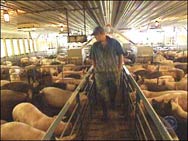
Piggy Power
Legion Field, Indiana ‘ for CBS News
Indiana’s seven ethanol plants and a fledgling wind power program are a pathetic response to the risks of climate change. But you can’t say the same for the small town of Reynolds, Ind. They have a population of just 500 people. But they have plenty of pigs.’150,000 in all.
Down the road, one of the nation’s largest dairy farms is proving that on a smaller scale ‘ you can use livestock to light your home.
“Each cow produces 100 pounds of manure a day. So we have a pretty good source of raw supply,” said Gary Corbitt, who runs Fair Oaks Farm.
That’s enough methane gas to power all of Fair Oaks Farm ‘ or more than 700 homes.
They installed the technology 18 months ago, and so far they’re barely breaking even.
“It’s been expensive but we’re absolutely convinced it is the way to go and it is the future,” he said.
And that’s how tiny Reynolds became “Bio-Town, USA,” the first town in the country to attempt to go entirely off-grid.
They traded in their cars for “flex-fuel” vehicles, so they could fill up with an ethanol blend made from local corn. And that’s now a full dollar cheaper than regular gas.
A few years ago, the small town had a big idea: What if the pigs could power the whole town?
“If you look at your gas and electric bill, it’ll motivate you to do something. We have to do something,” said Rick Buschman, who’s on the Reynolds Town Board.
They broke ground on the plant to turn pig waste into power in 2006. But today, it’s still an empty field.
“We’re into a situation where sometimes the technology just isn’t what we expected,” said Cary Aubrey of the Indiana Department of Agriculture.

One Response
With 150,000 hogs and the the right technology Bio Town can be setting pretty as folks used to say. By using a FACULATIVE digester the town would achieve total waste digestion. This means that during the spring pump out of their lagoon they would only have to deal with coffee colored odor free water thats 95 to 98% nutrient free. It can be sprayed onto fields with no worry of ground water contamination. All the mineral salts from the manure are converted into small dense sand sized crystals that can be marketed as environmentally safe fertelizer. Thwse crystals are water insoluable and are dissolved only by the acids of the plant roots. this gives you a fretilizer that need only be reapplied every three to five years , and that would save farmers and nursery owners a lot of time and money. Hog manure will produce just as much methane and electrical energy pound for pound as cattle manure. Bio Town is a great idea whose time is now.